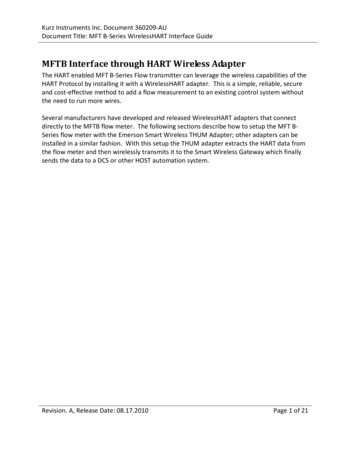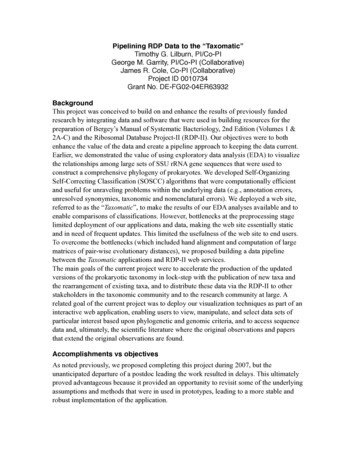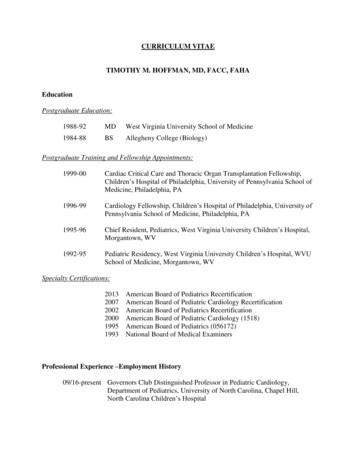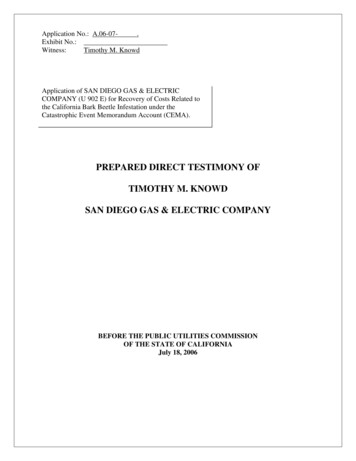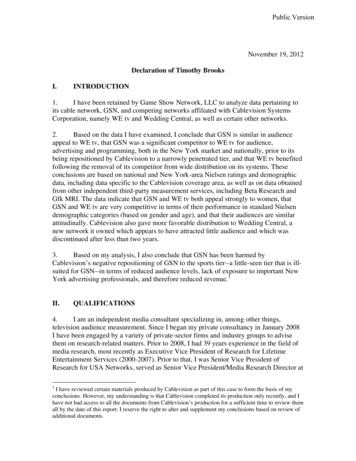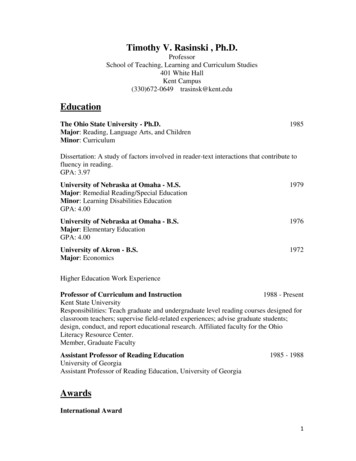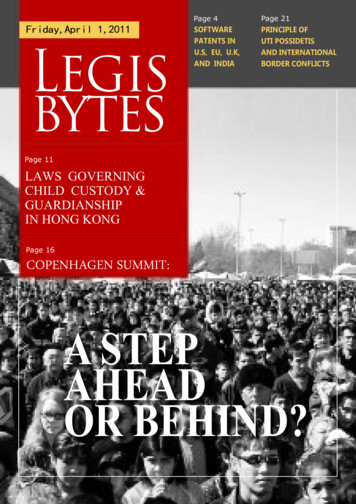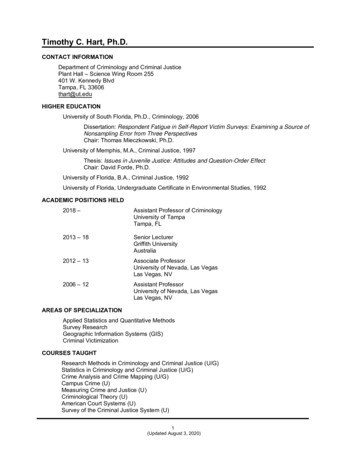
Transcription
Timothy C. Hart, Ph.D.CONTACT INFORMATIONDepartment of Criminology and Criminal JusticePlant Hall – Science Wing Room 255401 W. Kennedy BlvdTampa, FL 33606thart@ut.eduHIGHER EDUCATIONUniversity of South Florida, Ph.D., Criminology, 2006Dissertation: Respondent Fatigue in Self-Report Victim Surveys: Examining a Source ofNonsampling Error from Three PerspectivesChair: Thomas Mieczkowski, Ph.D.University of Memphis, M.A., Criminal Justice, 1997Thesis: Issues in Juvenile Justice: Attitudes and Question-Order EffectChair: David Forde, Ph.D.University of Florida, B.A., Criminal Justice, 1992University of Florida, Undergraduate Certificate in Environmental Studies, 1992ACADEMIC POSITIONS HELD2018 –Assistant Professor of CriminologyUniversity of TampaTampa, FL2013 – 18Senior LecturerGriffith UniversityAustralia2012 – 13Associate ProfessorUniversity of Nevada, Las VegasLas Vegas, NV2006 – 12Assistant ProfessorUniversity of Nevada, Las VegasLas Vegas, NVAREAS OF SPECIALIZATIONApplied Statistics and Quantitative MethodsSurvey ResearchGeographic Information Systems (GIS)Criminal VictimizationCOURSES TAUGHTResearch Methods in Criminology and Criminal Justice (U/G)Statistics in Criminology and Criminal Justice (U/G)Crime Analysis and Crime Mapping (U/G)Campus Crime (U)Measuring Crime and Justice (U)Criminological Theory (U)American Court Systems (U)Survey of the Criminal Justice System (U)1(Updated August 3, 2020)
IMPACT OF RESEARCH OUTPUTSGoogle Scholar (since 2015)h-Index(20.0)i10-index(33.0)m-Quotient (4.0)Scopush-Index(13)Citations(564)H-factor (215.65)Research GateRG Score(21.19)Citations(1,326)Reads(19,344)SOFTWARE APPLICATIONS1. Esteve, M., Moneva, A., & Hart, T. C. (2020). CACC: Conjunctive Analysis of Case Configurations. (RPackage Version 2.0.0). doi.org/10.5281/zenodo.34591122. Esteve, M., Moneva, A., & Hart, T. C. (2019). CACC: Conjunctive Analysis of Case Configurations. (RPackage Version 1.0.0). doi.org/10.5281/zenodo.3459112BOOKS1. Hart, T. C., Lersch, K. M., & Chataway, M. (2020). Space, time, and crime (5th ed.). Durham, NC:Carolina Press.2. Rennison, C. M., & Hart, T. C. (2018). Research methods in criminal justice and criminology.Thousand Oaks, CA: Sage.3. Hart, T. C., & Lersch, K. M. (2015). Space, time, and crime (4th ed.). Durham, NC: Carolina Press.4. Lersch, K. M. & Hart, T. C. (2011). Space, time, and crime (3rd ed.). Durham, NC: Carolina Press.5. Mosher, C. J., Miethe, T. D., & Hart, T. C. (2011). The mismeasure of crime (2nd ed.). ThousandOaks, CA: Sage.PEER-REVIEWED PUBLICATIONS1. Hart, T. C. (Revise and Resubmit – Criminal Justice Review). Investigating crime pattern stability atmicro-temporal intervals: Implications for crime analysis and hotspot policing strategies.2. Vaughan, A. D., Hart, T. C., Hewitt, A. N., & Felson, M. (2020). The promise and challenge of activitybased crime rates: A comparison of the United States, Canada, and Australia. European Journalon Criminal Policy and Research. Online First: doi.org/10.1007/s10610-020-09461-43. Moneva, A., Miro’-Llinares, F., & Hart, T. C. (2020). Hunter or prey? Exploring the situational profilesthat define online harassment repeat victims and offenders. Deviant Behavior. Online First:doi.org/10.1080/01639625.2020.17461354. Hart, T. C. (2019) Identifying situational clustering and quantifying its magnitude in dominant caseconfigurations: New methods for conjunctive analysis. Crime & Delinquency, 66(1), 143-159.doi.org/10.1177/00111287198661235. Moir, E., Stewart, A., Reynald, D. M., Hart, T. C. (2019). Guardianship in action among Brisbanesuburban residents: Environmental facilitators of guardianship intensity and the influence of livingin a Queenslander, Security Journal. OnLine First doi.org/10.1057/s41284-019-00210-96. Chataway, M. L., Hart, T. C., & Bond, C. (2019). The social-psychological process of fearing crime:Developing and testing a new momentary model of victimisation worry. Australian and NewZealand Journal of Criminology. doi.org/10.1177/00048658198361537. Moir, E., Reynald, D. M., Hart, T. C., & Stewart, A. (2019). Exploring the influence of dailymicroroutines on guardianship opportunities: An extension of routine activities theory. CriminalJustice Studies 32(2), 120-139. doi.org/10.1080/1478601X.2019.16008198. Chataway, M. L., & Hart, T. C. (2018). A social-psychological process of “fear of crime” for men andwomen: Revisiting an old paradox from a new perspective. Victims and Offenders, 14(2), 143164. doi.org/10.1080/15564886.2018.15522219. Moir, E., Hart, T. C., Reynald, D. M., Stewart, A. (2018). Typologies of suburban guardians:Understanding the importance of responsibility, opportunities, and routine activities in facilitatingsurveillance. Crime Prevention and Community Safety, 21(1), 1-21. doi.org/10.1057/s41300-0180057-410. Hart, T. C., & Moneva, A. (2018). Análisis Conjunto de Configuraciones de Caso: una introducción alPensamiento Configural. Revista Española de Investigación Criminológica, 16(3), 1-19.2(Updated August 3, 2020)
11. Chataway, M. L., & Hart, T. C. (2018). Crime prevention and reduction programs: How does knowingabout community initiatives moderate attitudes towards criminal victimization. Australian and NewZealand Journal of Criminology, 51(2), 239-257. doi.org/10.1177/000486581771705512. Chataway, M. L., Hart, T. C., Coomber, R., & Bond, C. (2017). The geography of crime fear: A pilotstudy exploring event-based perceptions of risk using mobile technology. Applied Geography, 86,300-307. doi.org/10.1016/j.apgeog.2017.06.01013. Moir, E., Stewart, A., Reynald, D. M., & Hart, T. C. (2017). Guardianship in action (GIA) withinBrisbane suburbs: The association between guardianship intensity and crime and changes overtime. International Criminal Justice Review, 42(3), 254-269. doi.org/10.1177/ 073401681772419914. Drawve, G., Thomas, S. A., & Hart, T. C. (2017). Routine activity theory and the likelihood of arrest: Areplication and extension with conjunctive methods. Journal of Contemporary Criminal Justice,33(2), 121-132. doi.org/10.1177/104398621668974715. Hart, T. C., Rennison, C. M., & Miethe, T. D. (2017). Identifying patterns of situational clustering andcontextual variability in criminological data: An overview of conjunctive analysis of caseconfigurations (CACC). Journal of Contemporary Criminal Justice, 33(2), 112-120. doi.org/10.1177/104398621668974616. Miethe, T. D., Troshynski, E. I., & Hart, T. C. (2017). Social conditions and cross-nationalimprisonment rates: Using set-theoretic methods for theory testing and identifying deviant cases.Journal of Contemporary Criminal Justice, 33(2), 152-172. doi.org/10.1177/104398 621668881517. Hart, T. C. (2016). Using typologies of victimization worry to create strategies for reducing fear ofcrime. Police Practice and Research: An International Journal, 18(4), 407-419. doi.org/10.1080/15614263.2016.123085418. Chataway, M., & Hart, T. C. (2016). (Re)assessing contemporary 'fear of crime' measures within anAustralian context. Journal of Environmental Psychology, 47, 195-203. doi.org/10.1016/j.jenvp2016.06.00419. Lockwood, K., Hart, T. C., & Stewart, A. (2015). First Nations Peoples and judicial sentencing: Maineffects and the impact of contextual variability. British Journal of Criminology, 55(4), 769-789.doi.org/10.1093/bjc/azv00520. Hart, T. C., & Miethe, T. D. (2015). Configural behavior settings of crime event locations: Towards analternative conceptualization of criminogenic micro-environments. Journal of Research in Crimeand Delinquency, 52(3), 373-402. doi.org/10.1177/002242781456663921. Hart, T. C., Miethe, T. D., & Regoeczi, W. C. (2014). Contextualizing sentencing disparities: Exploringa new approach for identifying variability. Criminal Justice Studies, 27(4), 344-361. doi.org/10.1080/1478601X.2014.94703122. Hart, T. C., & Zandbergen, P. A. (2014). Kernel density estimation and hotspot mapping: examiningthe influence of interpolation method, grid cell size, and bandwidth on crime forecasting. Policing:An International Journal of Police Strategies & Management, 37(2), 305-323. doi.org/10.1108/PIJPSM-04-2013-0039 Awarded the Journal’s Outstanding Paper of 2015.23. Hart, T. C., & Miethe, T. D. (2014). Street robbery and public bus stops: A case study of activitynodes and situational risk. Security Journal, 27(2), 180-193. doi.org/10.1057/sj.2014.524. Lersch, K. M., & Hart, T. C. (2014). Environmental justice, lead, and crime: Exploring the spatialdistribution and impact of industrial facilities in Hillsborough County, Florida. SociologicalSpectrum, 34(1), 1-21.25. Hart, T. C., & Waller, J. (2013). Neighborhood boundaries and structural determinants of socialdisorganization: Examining the validity of commonly used measures. Western CriminologyReview, 14(3), 16-33.26. Hart, T. C., Hart, J. L., & Miethe, T. D. (2013). The situational context of student bullying victimization:A conjunctive analysis of case configurations. Justice Research and Policy, 15(2), 43-73.27. Hart, T. C., & Zandbergen, P. A. (2013). Reference data and geocoding quality: Examiningcompleteness and positional accuracy of street geocoded crime incidents. Policing: AnInternational Journal of Police Strategies & Management, 36(2), 263-294. Awarded theJournal’s Highly Commendable Paper of 2014.28. Zandbergen, P. A., Hart, T. C., Lenzer, K. E., & Camponovo, M. E. (2012). Error propagation modelsto examine the effects of geocoding quality of spatial analysis of individual-level datasets. Spatialand Spatio-temporal Epidemiology, 3(1), 69-82.3(Updated August 3, 2020)
29. Hart, T. C., & Rennison, C. M. (2011). Violent victimization of Hispanic college students: Findingsfrom the National Crime Victimization Survey. Race & Justice: An International Journal, 1(4), 362385.30. Hart, T. C., & Colavito, V. (2011). College-student victims and reporting crime to the police: Theinfluence of collective efficacy. Western Criminology Review, 12(3), 1-19.31. Hart, T. C., & Miethe, T. D. (2011). Violence against college students and its situational contexts:Prevalence, patterns, and policy implications. Victims & Offenders, 6(2), 157-180.32. Zandbergen, P. A., Levenson, J., & Hart, T. C. (2010). Residential proximity to schools and daycares:An empirical analysis of sex offense recidivism. Criminal Justice and Behavior, 37(5), 482-502.33. Hart, T. C., & Miethe, T. D. (2009). Self-defensive gun use by crime victims: A conjunctive analysis ofits situational contexts. Journal of Contemporary Criminal Justice, 25(1), 6-19.34. Zandbergen, P. A., & Hart, T. C. (2009). Geocoding accuracy considerations in determiningresidency restrictions for sex offenders. Criminal Justice Policy Review, 20(1), 62-90.35. Hart, T. C., & Miethe, T. D. (2008). Exploring bystander presence and intervention in non-fatal violentvictimization: When does helping really help? Violence and Victims, 23(5), 637-651.36. Miethe, T. D., Hart, T. C., & Regoeczi, W. C. (2008). The conjunctive analysis of case configurations:An exploratory method for discrete multivariate analyses of crime data. Journal of QuantitativeCriminology, 24(2), 227-241.37. Zandbergen, P. A., & Hart, T. C. (2006). Reducing housing options for convicted sex offenders:Investigating the impact of residency restriction laws using GIS. Justice Research and Policy,8(2), 1-24.38. Hart, T. C., Rennison, C. M., & Gibson, C. (2005). Revisiting respondent ‘fatigue bias’ in the NationalCrime Victimization Survey. Journal of Quantitative Criminology, 21(3), 345-362.39. Hart, T. C. (1998). Causes and consequences of juvenile crime and violence: Public attitudes andquestion-order effect. American Journal of Criminal Justice, 23(1), 129-143.BOOK CHAPTERS1. Hart, T. C. (In Press). Conjunctive analysis of case configurations (CACC). In L. Groff and C.Haberman (Eds.), The Study of Crime and Place: A Methods Handbook) (pp. xx-xx).Philadelphia, PA: Temple University Press.2. Hart, T. C. (In Press). Conjunctive analysis of case configurations (CACC). In D. Forde and J. C.Barnes (Eds.), Encyclopedia of Research Methods and Statistical Techniques in Criminology andCriminal Justice (pp. xx-xx). Hoboken, NJ: Wiley-Blackwell.3. Hart, T. C. (2020). Hot spots of crime: Methods and predictive analytics. In Kim M. Lersch and JayChakraborty (Eds.), Geographies of Behavioral Health, Crime, and Disorder: The Intersection ofSocial Problems and Place (pp. 87-103). Abingdon, UK: Routledge.4. Dowsley, F. E., & Hart, T. C. (2017). Crime and justice data. In A. Deckert and R. Sarre (Eds.), TheAustralian and New Zealand Handbook of Criminology, Crime and Justice. (pp. 65-80). ANZSOC.5. Hart, T. C., & Troshynski, E. I. (2016). Perceptions of stalking victimization among behaviorallydefined victims: Examining factors that influence self-identification. In C. Rennison & C. Cuevas(Eds.), Handbook on the Psychology of Violence (pp. 158-178). Hoboken, NJ: Wiley-Blackwell.6. Hart, T. C., & Mithe, T. D. (2015). Public Bus Stops and the Meso Environment: Understanding theSituational Context of Street Robberies. In V. Ceccato & A. Newton (Eds.), Safety and Security inTransit Environments: An Interdisciplinary Approach (pp. 196-212). Hampshire, UK: Palgrave7. Hart, T. C. (2013). Violent victimization of college students: Findings from the National CrimeVictimization Survey. In J. Sloan & B. Fisher (Eds.), Campus Crime: Legal, Social, and PolicyPerspectives (3rd ed.) (pp. 141-157). Springfield, IL: C.C. Thomas.8. Hart, T. C. (2010). Age and victimization. In B.S. Fisher & S.P. Lab (Eds.), Encyclopedia ofVictimology and Crime Prevention (pp. 12-13). Thousand Oaks, CA: Sage.9. Hart, T. C. (2007). Using GIS to assess housing options for registered sex offenders. In K. Lersch(Ed.), Space, Time, and Crime, (2nd ed.) (pp. 243-244). Durham, NC: Carolina Press.10. Hart, T. C. (2007). Violent victimization of college students: Findings from the National CrimeVictimization Survey. In J. Sloan & B. Fisher (Eds.), Campus Crime: Legal, Social, and PolicyPerspectives (2nd ed.) (pp. 129-146). Springfield, IL: C.C. Thomas.4(Updated August 3, 2020)
TECHNICAL REPORTS/REPORTS TO FUNDING AGENCIES1. Birks, D., Townsley, M., & Hart, T. C. (2019). Predictive policing in an Australian context: Assessing viabilityand utility. Final Report (CRG 32/16-17). Prepared for the Australian Institute of Criminology.2. Ransley, J., Hart, T., & Bartlett, D. (2017). Evaluation of the Queensland Police Service's Trial of HubPolicing. Prepared for the Queensland Police Service.3. Hart, T. C. (2014). Conjunctive analysis of case configurations. JDiBrief Series. London: UCL JillDando Institute of Security and Crime Science. ISSN: 2050-4853.4. Hart, T. C., Chataway, M., Bartlett, D., Bond, C., Doyle, K., Hayes, H., & Wood, W. (2014). 2014 GoldCoast community survey: Summary report. Griffith University’s School of Criminology andCriminal Justice: Southport, QLD, Australia.5. Hart, T. C., & Flynn, K, & Savage, C. (2012). Arrest related deaths in Nevada, 2009-11. (CACS 20120101CR). University of Nevada, Las Vegas: Las Vegas, NV.6. Hart, T. C., & Culver, J. (2012). Criminal victimization in Nevada, 2011. (CACS 2012-0101EN).University of Nevada, Las Vegas: Las Vegas, NV.7. Hart, T. C., & Zandbergen, P. A. (2012). Effects of data quality on predictive hotspot mapping (NCJ239861). Final technical report prepared for the National Institute of Justice in compliance withcooperative agreement #2009-IJ-CX-0022. Washington, DC.8. Madensen, T. D., Hart, T. C., & Miethe, T. D. (2011). The impact of foreclosures on neighborhoodcrime in Nevada, 2006-09. (CACS 2011-0101BJS). University of Nevada, Las Vegas: Las Vegas,NV.9. Waller, J., Hart, T. C., & Miethe, T. D. (2011). Justice Assistance Grant (JAG) Program in Nevada,2005-10. (CACS 2011-0101DPS). University of Nevada, Las Vegas: Las Vegas, NV.10. Miethe, T. D., & Hart, T. C. (2011). (Non)Sense about the criminal victimization of college students:Why SB-231 is bad public policy. The Alliance, April/May, 7.11. Sakiyama, M., Miethe, T. D., & Hart, T. C. (2010). Clearance rates in Nevada, 1998-2009. (CACS2010-0102EN). University of Nevada, Las Vegas: Las Vegas, NV.12. Hart, T. C., Kelly, B., & LaHaie, C. (2010). Arrest-related deaths in Nevada, 2009. (CACS 20100101CR). University of Nevada, Las Vegas: Las Vegas, NV.13. Shields, D., Miethe, T. D., & Hart, T. C. (2010). Auto theft in Nevada, 1994-2008. (CACS 20100101EN). University of Nevada, Las Vegas: Las Vegas, NV.14. Brehman, B. R., Hart, T. C., & Miethe, T. D. (2010). Communication intercepts authorized in Nevada,1997-2008. (CACS 2010-0101AJ). University of Nevada, Las Vegas: Las Vegas, NV.15. Zandbergen, P., & Hart, T. C. (2009). Availability and spatial distribution of affordable housing inMiami‐Dade County and implications of residency restriction zones for registered sex offenders.Final technical report prepared for the Miami Coalition for the Homeless. Miami, FL.16. Zandbergen, P., & Hart, T. C. (2009). Availability of affordable rental housing in Miami‐Dade Countyunder a proposed 1,750 feet residency restriction zone. Addendum to: Availability and spatialdistribution of affordable housing in Miami‐Dade County and implications of residency restrictionzones for registered sex offenders. Prepared for the Miami Coalition for the Homeless.17. Hart, T. C., McGaha, M., & LaHaie, C. (2009). Criminal victimization in Nevada, 2008. (CACS 200901-05EN). University of Nevada, Las Vegas: Las Vegas, NV.18. LaHaie, C. B., Miethe, T. D., & Hart, T. C. (2009). Arson trends in Nevada, 1997-2006. (CACS 200901-01EN). University of Nevada, Las Vegas: Las Vegas, NV.19. Wilk, T., Miethe, T. D., & Hart, T. C. (2009). Burglary trends in Nevada, 1990-2007. (CACS 2009-0102EN). University of Nevada, Las Vegas: Las Vegas, NV.20. Kobus, K. D., Miethe, T. D., & Hart, T. C. (2009). Patterns in school violence in Nevada. (CACS2009-01-04EN). University of Nevada, Las Vegas: Las Vegas, NV.21. Ruggieri, C., Miethe, T. D., & Hart, T. C. (2009). Rape and other sex offenses in Nevada, 1990-2007.(CACS 2009-01-03EN).22. Miethe, T. D., & Hart, T.C. (2009). Capital punishment in Nevada, 1977-2008. (CACS 20090101SS). University of Nevada, Las Vegas: Las Vegas, NV.23. Brehman, B. R., Miethe, T. D., & Hart, T. C. (2009). Deaths in custody in Nevada, 2001- 2006.(CACS 2009-0101CR). University of Nevada, Las Vegas: Las Vegas, NV.5(Updated August 3, 2020)
24. Zandbergen, P., Levenson, J., & Hart, T. C. (2008). The influence of residential proximity to schoolsand daycare centers on sex offense recidivism: An empirical analysis. Prepared for the CountyCommission of Broward County, Florida.25. Radtke, T., Sousa, W., & Hart, T. C. (2008). Operation Ceasefire in Clark County, Nevada:Evaluating a cross-jurisdictional approach to reducing gun violence. Final technical reportprepared for the Bureau of Justice Statistics in compliance with grant #2007-30243-NV-BJ.Washington, DC.26. Hart, T. C., & Rennison, C. M. (2007). Response effects: What can the National Crime VictimizationSurvey tell us? Prepared for the Bureau of Justice Statistics. Washington, DC.27. Hart, T. C., & Wilson, M. (2006). 2005 Community survey: Final report. Prepared for the HillsboroughCounty Sheriff’s Office. Tampa, FL: Department of Criminology, University of South Florida.28. Hart, T. C. (2005). 2004 Community survey: Final report. Prepared for the Hillsborough CountySheriff’s Office. Tampa, FL: Department of Criminology, University of South Florida.29. Hart, T. C. (2003). Violent victimization of college students, 1995-2000. (NCJ-196143). Washington,DC: USGPO.30. Hart, T. C., & Rennison, C. M. (2003). Reporting crime to the police, 1992-2000. (NCJ-195710).Washington, DC: USGPO.31. Reaves, B. A., & Hart, T. C. (2001). Federal law enforcement officers, 2000. (NCJ-187231).Washington, DC: USGPO.32. Reaves, B. A., & Hart, T. C. (2000). Law enforcement management and administrative statistics,1999: Data for individual state and local agencies with 100 or
University of Florida, Undergraduate Certificate in Environmental Studies, 1992 . ACADEMIC POSITIONS HELD 2018 – Assistant Professor of Criminology University of Tampa Tampa, FL 2013 – 18 Senior Lecturer Griffith University Australia 2012 – 13 . Associate Professor

